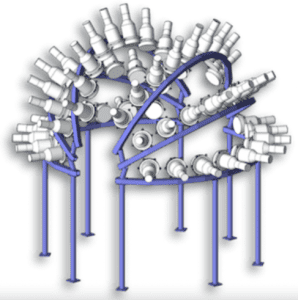TAG: GS 3: SCIENCE AND TECHNOLOGY
THE CONTEXT: India’s nuclear power programme is making significant strides, with a recent study providing crucial insights into the fission characteristics of plutonium isotopes, specifically Pu-240.
EXPLANATION:
- This research holds considerable implications for nuclear reactor design, nuclear medicine, and our understanding of nuclear reactions.
- Researchers at the Los Alamos Neutron Science Centre (LANSCE) conducted the experiment by striking a tungsten disc with proton pulses to produce neutrons with energies ranging from 0.01 to 800 MeV.
- These neutrons were directed to a chamber containing 99.875% pure Pu-240.
- The experimental setup included liquid scintillators to track the neutron emissions and fission products from the Pu-240 sample.
- The Pu-240 sample weighed only 20 milligrams to minimize alpha particle emissions.
- The researchers meticulously subtracted contributions from spontaneous fission and other sources to isolate data specific to neutron-induced fission, analyzing incident neutrons of energies between 1-20 MeV.

A computer-generated rendering of the liquid scintillator detector system at LANSCE. The Pu-240 sample is located at the centre and neutrons intended to bombard the sample enter from the bottom left side.
India’s Nuclear Power Programme: A Shift to Plutonium Fission
- On March 4, India marked a significant milestone by initiating the core-loading process of the prototype fast breeder reactor (PFBR) at the Madras Atomic Power Station in Kalpakkam.
- This event signifies the transition to the second stage of India’s nuclear power programme, focusing on plutonium fission.
- The first stage involved using uranium isotopes in pressurised heavy-water reactors to produce Pu-239 and energy.
Plutonium-240 (Pu-240)
- When Pu-239 captures a neutron, it has a 27-38% chance of converting to Pu-240 instead of undergoing fission.
- Pu-240 is present in many nuclear reactors and the fallout of nuclear weapon tests.
- Upon capturing a neutron, Pu-240 typically transforms into Pu-241, but it can occasionally undergo fission, leading to uncertainty about the energy distribution of its fission products.
Prompt Fission Neutron Spectrum (PFNS)
- A crucial aspect of fission energy is the prompt fission neutron spectrum (PFNS), representing neutrons emitted immediately after fission but before the nucleus stabilizes.
- Only one previous study attempted to measure the PFNS of induced fission in Pu-240 using neutrons with an energy of 0.85 MeV.
- Recently, U.S. researchers conducted the second-ever measurement, using neutrons with energy greater than 0.85 MeV, providing new insights and revealing significant discrepancies between predicted and measured PFNS.
Findings and Implications
- The study reported several significant findings:
- Discrepancies in PFNS Predictions: There were notable differences between the predicted and observed PFNS, indicating the need for updated models and nuclear data libraries.
- Higher Rate of Second-Chance Fission: The researchers found a higher-than-expected rate of second-chance fission, where a nucleus becomes fissionable after losing a neutron.
- Evidence of Third-Chance Fission: Signs of third-chance fission were observed, though these were challenging to quantify directly from the data.
- These findings are pivotal for various applications, including reactor design, nuclear medicine, and understanding nuclear reactions.
Relevance to India’s PFBR
- The prototype fast breeder reactor (PFBR) utilizes plutonium recovered from CANDU reactor spent fuel, which contains significant amounts of Pu-240.
- Insights into Pu-240 behavior are crucial for optimizing reactor performance and reprocessing spent fuel from the PFBR.
Contributions to Nuclear Data Libraries
- The study emphasized updating nuclear data libraries, such as the ENDF, JEFF-3.3, and JENDL-5.0, to incorporate the new findings.
- Notably, the JENDL-5.0 library includes both multi-chance fission and pre-equilibrium neutron emission processes, unlike ENDF/B-VIII.0 and JEFF-3.3, which lack pre-equilibrium data.

